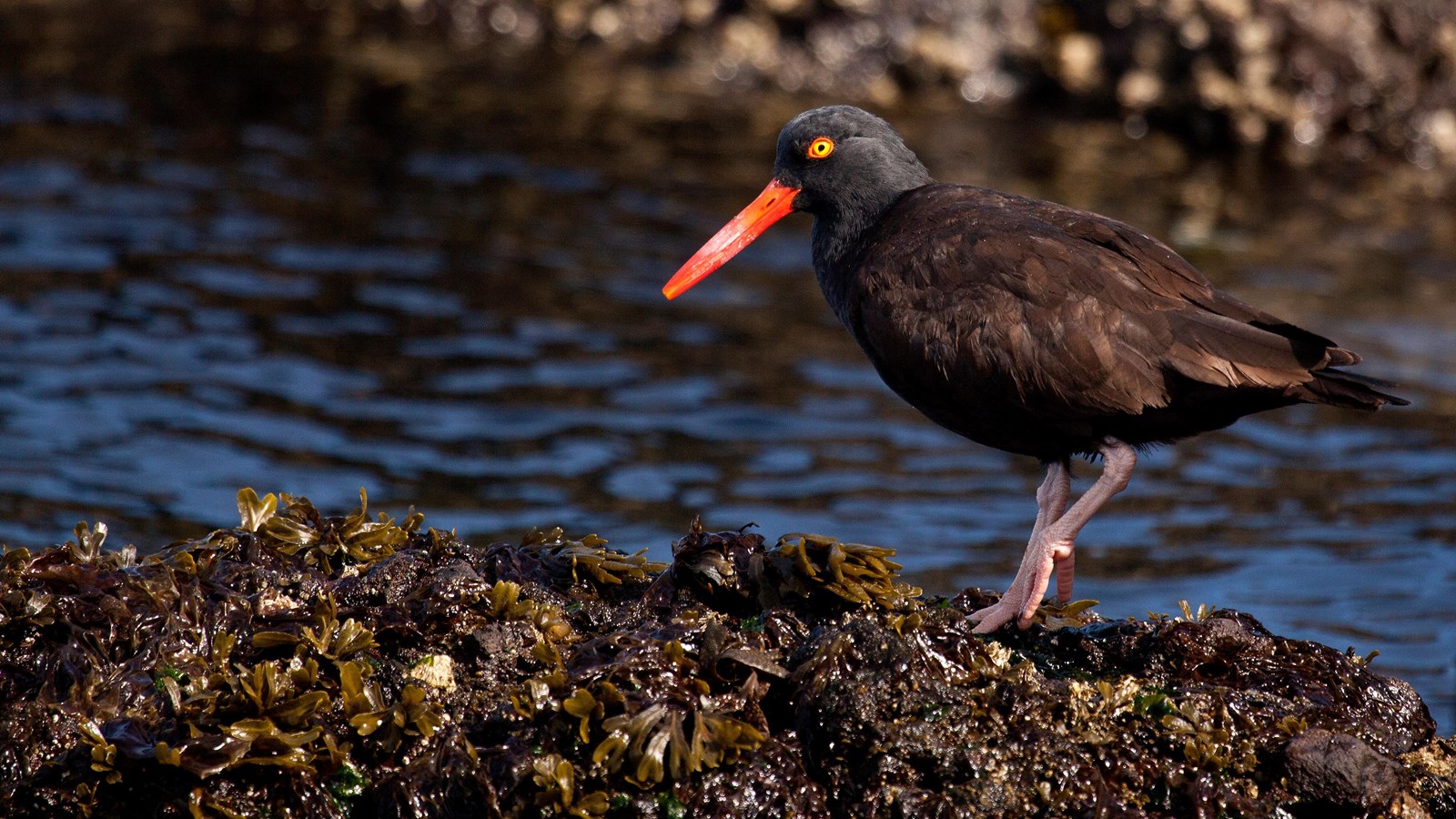I don't remember seeing them this far north on the coast near San Francisco before but I know they live on the Channel Islands of California a lot.
begin quote from:
https://www.nps.gov/places/black-oystercatcher.htm
Place
Black Oystercatcher

Tim Hauf, timhaufphotography.com
Scientific Name
Haematopus bachmani
Introduction
The black oystercatcher is the signature bird of the rocky intertidal
coastline. It is a permanent resident on all five islands in the park,
being restricted in its range, never straying far from shores and
particularly favoring rocky shorelines. It has been suggested that this
bird is seen mostly on coastal stretches which have some quieter
embayments, such as jetty protected areas. It hunts through the
intertidal area, searching for food visually, often so close to the
water's edge it has to fly up to avoid crashing surf.
Quick and Cool Facts
- Despite its name, this prominently-sized black bird with large feet seldom eats oysters.
- Although they don't swim, black oystercatcher chicks will sometimes dive under water to avoid predators.
- Migrating only short distances or not at all, they are permanent residents of their breeding range.
- The black oystercatcher can live for more than15 years.
- Monogamous pairs make their nests by tossing rock flakes, pebbles or shell fragments toward their nest bowl with a sideways or backward flip of their bills. They use the same nest year after year.
- Limpets and mussels have a strong muscle that holds the two shells tightly together—yet an oystercatcher can easily and quickly pry them open.
- The black oystercatcher has a very loud piercing whistle that can be heard at great distance over crashing waves.
Appearance
The black oystercatcher is a distinctive, crow-sized, short-tailed,
all-black shorebird. It has pale pinkish legs and a long, bright
reddish-orange bill and eye-ring.
Range
Oystercatchers breed from the western Aleutian Islands in Alaska south
to central Baja, California. Within Alaska, they have ranged northward
to the Pribilof Islands in winter and to Round Island, Bristol Bay, to
nest in the summer. It is a permanent resident on all five islands in
the park. Ranges of the black oystercatcher and the brown-and-white
American oystercatcher overlap in Baja California.
Habitat
Oystercatchers never stray far from shore and favor rocky shorelines in
particular. It has been suggested that this bird is seen mostly on
coastal stretches which have some quieter embayments, such as jetty
protected areas.
Feeding
Mussels and limpets are their primary food, but black oystercatchers
prey on a wide range of shellfish and other creatures found along the
rocky shore. They locate open mussels and disable them with a quick jab
to the adductor muscle. With the mussel stuck in the open position, the
oystercatcher can pull out the contents with the tip of its chisel-like
bill. Oystercatchers often forage in the wave zone, because mussels that
are splashed by waves open more frequently.
Reproduction
The female black oystercatcher lays two to three eggs among pebbles in a
shallow rocky depression or in a hollow on the beach above the high
tide line. The nest is built by both the male and the female. They will
create or scrape a depression in the ground and then pick up and toss
shells and bits of rocks and pebbles into the depression with a
backwards or sideways flip of their heads. They use the same nest
year-after-year. Both the male and the female take turns incubating the
eggs. The eggs incubate for 24-29 days and the chicks fledge in about 35
days. The chicks remain close to the nest at first. One of the parents
will stay with them while the other parent forages for food to bring
back to the nest. Eventually, the chicks will go with their parents to
feeding areas. The chicks fledge at about five weeks and will forage on
their own, but they will still occasionally be fed by their parents. The
female has one brood a year.
Conservation Status
The black oystercatcher, with a global population of 10,000-12,000
individuals, is considered rare. It is completely dependent on marine
shorelines, favoring sheltered areas of high tidal variation that
support limpets and mussels, their preferred food. Their numbers are
highest from Alaska to British Columbia, where there is relatively
plentiful preferred habitat and lower levels of disturbance than in the
southern portion of the range.
The U.S. Fish & Wildlife Service selected the black oystercatcher as a Focal Species for Conservation Action due to small population size, restricted range, threats to preferred habitat, lack of baseline data to assess conservation status, and a suite of ongoing and anthropogenic and natural factors that may limit long-term viability. The U.S. Fish & Wildlife Service and other agencies in 2007 developed a range-wide conservation action plan and working group, which is the unified resource and blueprint for tracking and conserving the species.
Additional Information
Anders, Brad A. (1998) Black Oystercatcher. retrieved Dec 20, 2011
http://en.wikipedia.org/wiki/Black_Oystercatcher
http://identify.whatbird.com/obj/999/overview/Black_Oystercatcher.aspx
https://www.montereybayaquarium.org/animals/animals-a-to-z/black-oystercatcher
http://www.birdweb.org/birdweb/bird/black_oystercatcher
http://www.nhptv.org/natureworks/blackoystercatcher.htm
https://www.audubon.org/field-guide/bird/black-oystercatcher
2011 survey and reference to anticipated bird count, California Audubon Society

No comments:
Post a Comment